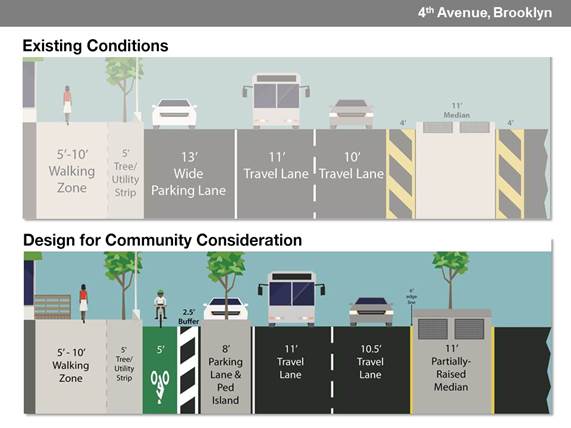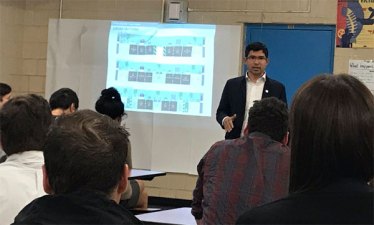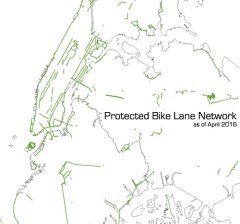DOT Is Getting Serious About Protected Bike Lanes for 4th Avenue

DOT will present a redesign for Brooklyn’s Fourth Avenue that includes protected bike lanes from 65th Street to Dean Street, Transportation Commissioner Polly Trottenberg said today.
The announcement signals an important shift from earlier plans that called for casting the current design of Fourth Avenue in concrete without adding bike infrastructure. The new design concept is very encouraging because it shows DOT is willing to adjust major street reconstruction projects to maximize safety and extend the bike network. The question now is whether the agency will follow through and implement the more ambitious design.
In 2012 and 2013, DOT installed wider medians and other pedestrian safety improvements along Fourth Avenue, cutting pedestrian injuries by 61 percent in Park Slope and 30 percent in Sunset Park. The agency planned to build out that design in permanent materials this year as part of Mayor de Blasio’s “Vision Zero Great Streets” initiative, which would have squandered a once-in-a-generation opportunity to add safe bike infrastructure on the best available route linking Bay Ridge, Sunset Park, and Park Slope.
The new proposal, which will get public hearings at an upcoming workshop and presentations to community boards 2, 6, and 7, replaces the previous plan’s 13-foot parking lanes with five-foot curbside bike lanes protected by a 2.5-foot buffer and eight-foot parking lane with concrete islands at pedestrian crossings.
Not only would that design make many more New Yorkers comfortable biking on Fourth Avenue, crossing distances for pedestrians will also be shorter thanks to the concrete islands. The overall safety improvement should be greater than the initial design.
“The chance to redesign one of New York City’s ‘Great Streets’ may only come about every fifty years, and so it’s critical we get it right,” Trottenberg said in a statement. “The dramatic surge in cycling, combined with safety changes that have dramatically improved Fourth Avenue’s safety and livability, have simply transformed the way Brooklynites see this street.”
Very few major two-way streets in New York have protected bike lanes, but these are the streets that need attention to create a citywide, low-stress bike network. This project could set an important precedent for similar two-way arterial streets going forward. (Fourth Avenue is not quite as wide as Queens Boulevard, where protected bike lanes are less challenging to implement in some ways, since DOT has more extraneous asphalt to work with.)
Council Member Carlos Menchaca has championed the idea of adjusting the Fourth Avenue design in meetings with DOT about the project since last March.
“I thank the DOT and Sunset Park’s Community Board 7 for accomplishing something government seldom does; pausing a large construction project, listening to the people, and considering additional options like pedestrian safety islands and protected bike lanes,” Menchaca said today.


